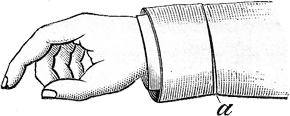
|
foreword to the online edition I. introductory II. common sharpers and their tricks III. marked cards and the manner of their employment IV. reflectors V. holdouts VI. manipulation VIII. the game of faro IX. prepared cards X. dice XI. high ball poker XII. roulette and allied games XIII. sporting houses XIV. sharps and flats
|
SHARPS AND FLATS
CHAPTER V HOLDOUTS
The Cuff Holdout
The cuff-pocket, above alluded to, was a very early invention. As its name indicates, it was a pocket inside the coat sleeve, the opening to which was situated n the under side at the seam joining sleeve and cuff. In fig. 25 'a' denotes the opening of the pocket
FIG. 25 In a game of poker it would be employed as follows. Whilst shuffling the cards, the sharp would contrive to get three of a kind at the top of the pack. He would then insert his little finger between these three cards and the rest, the pack being in the left hand. Then holding his hand in front of him he would reach across it with the other, for the (apparently) simple purpose of laying down his cigar, upon his extreme left, or if he were not smoking he might lean over in the same manner to 'monkey with his chips' (i.e. to arrange his counters). In this position the orifice of the pocket would come level with the front end of the pack, the latter being completely covered by his right arm. This would give him an opportunity of pushing the three selected cards into the pocket, where they would remain until he had dealt out all the cards and given off all the 'draft' except his own. Still holding the pack in his left hand, and his hand in front of him, he would again cross his right hand over, this time for the purpose of taking up and examining his own hand of cards, which he had taken the precaution of dealing well to the left, to give him an excuse for crossing his hands. He would then remove the cards from the cuff-pocket to the top of the pack, and lay the whole down upon the table. His manúuvring having been successful so far, he would now throw away three indifferent cards from his hand and deliberately help himself to the three top cards of the pack. These, of course, would be the three (aces for preference) which he had previously had concealed in the pocket. Thus, he is bound to have a 'full,' in any case. If he had been so fortunate as to possess another ace among the cards which fell to his hand on the deal, he would have a 'four'; which can only be beaten when 'straights' are played by a 'straight flush' in other words, a sequence of five cards, all of the same suit. His chances of 'winning the pot,' then, are infinite as compared with those of the other players. The great disadvantage of the cuff-pocket was the difficulty of removing the cards when once they had been put into it. To facilitate their removal, therefore, the pocket was sometimes provided with a slide, having a projecting stud, which could be drawn with the finger. This would throw the cards out into the hand. This description will serve to enlighten the reader as to the advantages to be gained by substituting the cuff holdout in place of the pocket which it is intended to supplant. It fulfils its purpose in a much more perfect manner, being far easier to use, and requiring less skill on the part of the operator.
|
| « holdouts (the bug) | holdouts (topping the deck) » |
home | introduction | book content | links | advertising | contact
